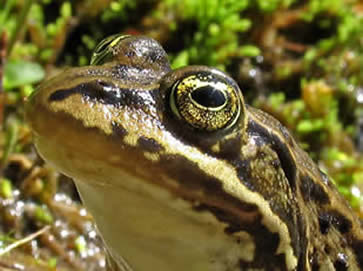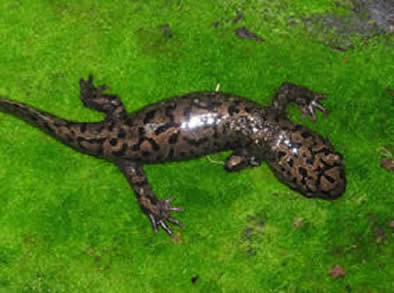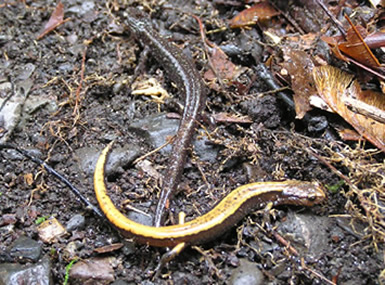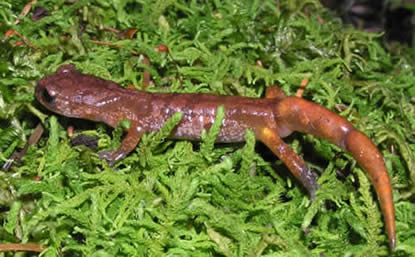

AN INTRODUCTION TO THE AMPHIBIANS
OF BRITISH COLUMBIA

Columbia Spotted Frog (Rana luteiventris), photo by Werner Eigelsreiter.
by
Visit the Amphibian Atlas Pages
The word "amphibian" means "double life," and refers to the tendency of most amphibians (frogs, toads, and salamanders) to have an aquatic, gill-bearing larval stage (i.e. tadpole stage for frogs) and an air-breathing adult stage that may live partially or almost entirely on land.
There are three extant (living) orders or main groups of amphibians in the world:
Amphibians are vertebrate animals, possessing a backbone and other elements of an internal bony skeleton. They are ectothermic, or "cold-blooded," meaning that their internal body temperature is dependent on the temperature of their surroundings. The skin of most amphibians is delicate, and can absorb water. Most amphibians respire partially through their skin. Because of this, water-borne pollutants and pathogens can cause serious damage to amphibian populations.
Worldwide, amphibians are declining in numbers. Experts believe the factors responsible include:
Red-legged Frog (Rana aurora), photo by Brian Klinkenberg
Amphibians in British Columbia
There are thirteen species of frogs and toads (anurans) and nine species of salamanders in British Columbia. Many of our BC species are southern species that are more common in the United States. For these species, our BC populations are peripheral, occurring at the northern edge of their range. Others, however, are widely distributed within B.C. and are not peripheral species.
Most species are found at low elevations in and near wetlands or riparian habitats. However, there are species of both frogs and salamanders in BC that are adapted to life in fast-flowing mountain streams. There is also one desert-adapted frog, the Great Basin Spadefoot, which occurs in dry southern interior areas, particularly within the Thompson, Okanagan and Similkameen Valleys.
Some British Columbia species of amphibians do not have the typical aquatic-terrestrial life history. The Western Red-backed salamander, Cour d'Alene Salamander, Wandering Salamander, and Ensatina lay eggs in damp places on land, and lack an aquatic larval stage. Coastal Giant Salamanders, Northwestern Salamanders, and Tiger Salamanders have neotenic life stages, which retain gills and remain aquatic throughout their life after reaching sexual maturity.

Coastal Giant Salmander (Dicamptodon tenebrosus), photo by Hugh Griffith
Conservation Concerns
It is partly because many amphibian species require both particular aquatic and terrestrial habitats that amphibians throughout the world are in decline, since loss or degradation of either habitat can eradicate a population. Aquatic stages are particularly vulnerable to environmental changes. Any slight alteration of water temperature, turbidity, dissolved oxygen levels, other characteristics of water chemistry, predatory regime, or physical complexity of habitat, can be harmful. Because embryos develop in eggs that are laid in shallow water, it is also possible that increased ultraviolet radiation, caused by depletion of the earth's ozone layer, plays a role in mortality (Blaustein et al., 1998; Trenham and Diamond, accessed 2005). Most amphibians have moist, sensitive skin, which is involved in both drinking and dermal respiration. Industrial pollution and pesticide run-off are thus threats at any life stage. Recently, amphibian populations worldwide have been found to be infected with chytridiomycete fungi (Weldon et al., 2004), which causes dermal damage and mortality in terrestrial forms. Another fungus (Saprolegnia ferax), introduced into bodies of water during fish stocking, has been linked to the death of amphibian eggs (Kiesecker et al., 2001).
In British Columbia, habitat destruction and range fragmentation are endangering a number of species. Draining of wetlands, and flood-control measures in expanding urban and agricultural areas, remove vast areas of habitat, and break historical distributions into disconnected fragments. Clearing of forests, and secondary effects from logging practices, impact both larval and adult stages. Several species have very restricted, relictual ranges which make them highly vulnerable to aquatic habitat degradation or the introduction of predatory game or baitfish into breeding lakes.
The amphibians of British Columbia are listed in the following tables, with links to discussions of species that are threatened or endangered in the province.

Western Red-backed Salamander (Plethodon vehiculum), colour morphs.
Photo by Hugh Griffith.
| Common Name | Species | Ecoprovince |
Rocky Mountain Tailed Frog |
Ascaphus montanus | Southern Interior Mountains |
Coastal Tailed Frog |
Ascaphus truei | Northern Boreal Mountains, Coast and Mountains, Georgia Depression |
Pacific Treefrog |
Hyla regilla | Coast and Mountains, Georgia Depression, Central Interior, Southern Interior, Southern Interior Mountains |
| Boreal Chorus Frog | Pseudacris maculata | Northern Boreal Mountains |
| Red-legged Frog | Rana aurora | Georgia Depression, Coast and Mountains |
| Bullfrog | Rana catesbieana | |
| Green Frog | Rana clamitans | |
| Columbian Spotted Frog | Rana luteiventris | Northern Boreal Mountains, Sub-boreal Interior, Central Interior, Southern Interior, Southern Interior Mountains |
| Northern Leopard Frog | Rana pipiens | Southern Interior |
| Oregon Spotted Frog | Rana pretiosa | Georgia Depression |
| Wood Frog | Rana sylvatica | Northern Boreal Mountains, Taiga Plains, Boreal Plains, Central Interior, Southern Interior, Southern Interior Mountains |
| Western Toad | Bufo boreas | Northern Boreal Mountains, Coast and Mountains, Georgia Depression, Taiga Plains, Boreal Plains, Central Interior, Southern Interior, Southern Interior Mountains |
| Great Basin Spadefoot Toad | Spea intermontana | Southern Interior |

Ensatina (Ensatina eschscholtzii). Photo by Hugh Griffith.
| Common Name | Species | Distribution
in BC |
| Northwestern Salamander | Ambystoma gracile | Coast and Mountains, Georgia Depression |
| Western Long-toed Salamander | Ambystoma macrodactylum | Coast and Mountains, Georgia Depression, Sub-boreal Interior, Central Interior, Southern Interior, Southern Interior Mountains |
| Tiger Salamander | Ambystoma tigrinum | Southern Interior |
| Coastal Giant Salamander (formerly known as the Pacific Giant Salamander) | Dicamptodon tenebrosus | Georgia Depression |
| Wandering Salamander | Aneides vagrans | Coast and Mountains (s. Vancouver Island) |
| Plethodon idahoensis | Southern Interior, Southern Interior Mountains | |
| Western Redback Salamander | Plethodon vehiculum | Coast and Mountains, Georgia Depression, Southern Interior |
| Ensatina | Ensatina eschscholtzii | Coast and Mountains, Georgia Depression |
| Roughskin Newt | Taricha granulosa | Coast and Mountains, Georgia Depression |
References Cited
Blaustein, A. R., J. M. Kiesecker, D. P. Chivers, D. G. Hokit, A. Marco, L.K. Beldon, and A. Hatch. 1998. Effects of ultraviolet radiation on amphibians: field experiments. American Zoologist 38: 799-812.
Kiesecker, J. M., A. R. Blaustein and C. L. Miller. 2001. Transfer of a pathogen from fish to amphibians. Conservation Biology 15: 1064-1070.
Trenham, P.C. and S.A. Diamond. 2005. UV and Amphibians in Wetlands. Coordinated studies of ultraviolet radiation and lentic breeding amphibians. Accessed December 2005.
Weldon C, du Preez L. H., Hyatt A. D., Muller R., Speare R. Origin of the amphibian chytrid fungus. Emerging Infectious Diseases [serial on the Internet]. 2004 Dec [cited 2005 Dec]. Available: http://www.cdc.gov/ncidod/EID/vol10no12/03-0804.htm
Additional Reading
Adama, D. B., K. Lansley, and M. A. Beaucher. 2004. Northern Leopard Frogs (Rana pipiens) Recovery: Captive rearing and reintroduction in Southeast British Columbia, 2003. Report to the Columbia Basin Fish and Wildlife Compensation Program. Nelson, BC. 26 pp.
AmphibiaWeb: Information on amphibian biology and conservation. [web application]. 2006. Berkeley, California: AmphibiaWeb. Available: http://amphibiaweb.org/. Accessed January 2006.
Boyle, C. A., L. Lavkulich, H. Schreier and E. Kiss. Changes in land cover and subsequent effects on Lower Fraser Basin Ecosystems from 1827 to 1990. Environmental Management 21: 185-196
B.C. Conservation Data Centre. 2005. Conservation Status Report: Rana pipiens. BC Ministry of Sustainable Resource Management. Available: http://srmapps.gov.bc.ca/apps/eswp/
Collins, J. T. and T. W. Taggart. 2002. Standard Common and Current Scientific Names for North American Amphibians, Turtles, Reptiles and Crocodilians. 5th Edition. Center for North American Herpetology, Lawrence Kansas. iv + 44 pp.
Corkran, C. and C. Thoms. 2006. Amphibians of Oregon, Washington and British Columbia. A Field Identification Guide. Lone Pine. Vancouver. 176 pp.
Green, D. M. and W. Campbell. 1984. Amphibians of British Columbia. Royal British Columbia Museum Handbook. Victoria, BC.
Green, D. M., H. Kaiser, T. F. Sharbel, J. Kearsley and K. R. McAllister. 1997. Cryptic species of spotted frogs, Rana pretiosa complex, in western North America. Copeia 1997: 1-8.
Haycock, R. D. 2000. COSEWIC status report on the Oregon spotted frog Rana pretiosa in Canada. Committee on the Status of Endangered Wildlife in Canada. Ottawa, Ontario. 22 pp.
Jackman, T. R. 1998. Molecular and historical evidence for the introduction of clouded salamanders (genus Aneides) to Vancouver Island, British Columbia, Canada, from California. Canadian Journal of Zoology 76: 1570-1580.
Johnston, B. Coastal Giant Salamander. 2004. Accounts for Managing Identified Wildlife. BC Ministry of Environment, Lands and Air Protection, Vancouver, BC.
Johnston, B. and L. Frid. 2002. Clearcut logging restricts the movements of terrestrial Pacific giant salamanders (Dicamptodon tenebrosus Good). Canadian Journal of Zoology 80: 2170-2177.
Mallory, A. 2004. Coastal Tailed Frog Ascaphus truei. Accounts and Measures for Managing Identified Wildlife. B.C. Ministry of Water, Land and Air Protection, Vancouver BC.
Matsuda, B. M., D. M. Green and P. T Gregory. 2006. Amphibians and Reptiles of British Columbia. Royal BC Museum Handbook. Victoria. 266 pp.
Maxcy, K. A. 2004. Red-legged Frog. Accounts and Measures for Managing Identified Wildlife. B.C. Ministry of Water, Land and Air Protection. Vancouver BC. Accounts V. 2004. 12 pp. PDF
Natureserve Explorer, 2005. www.natureserve.org.
Northern Prairie Wildlife Research Center. 1997. Checklist of Amphibian Species and Identification Guide. An Online Guide for the Identification of Amphibians in North America north of Mexico. North American Reporting Center for Amphibian Malformations. Jamestown, ND: Northern Prairie Wildlife Research Center Home Page. http://www.npwrc.usgs.gov/narcam/idguide/ (Version 30 Sept., 2002).
Ovaska, K. and L. Sopuck. 2004. Update COSEWIC Status report on the Red-legged Frog, Rana aurora, in Canada. Report prepared for the Committee on the Status of Endangered Wildlife in Canada. Ottawa, Ontario. 46 pp.
Reimchen, T. E. 1990. Introduction and dispersal of the Pacific treefrog, HYLA REGILLA, on the Queen Charlotte Islands, British Columbia. Canadian Field Naturalist 105:288-290.
Richardson, J. S. and W. E. Neill. 1998. Headwater amphibians and forestry in British Columbia: Pacific Giant Salamanders and Tailed frogs. Northwest Science 72: 122-123.
Ritland, K., L. A. Dupuis, F. L. Bunnell, W. L. Y. Hung and J.E. Carlson. 2000. Phylogeography of the tailed frog (Ascaphus truei) in British Columbia. Canadian Journal of Zoology 78: 1749-1758.
Schock, D. M. 2001. COSEWIC Status Report on the Tiger Salamander, Ambystoma tigrinum, in Canada. Committee on the Status of Endangered Wildlife in Canada. 43 pp.
Seburn, C.N.L. and D. Seburn. 2000. Status Report: northern leopard frog (Rana pipiens) (Western population). Committee on the Status of Endangered Wildlife in Canada. 43 pp.
Waye, H. 1999. Status report on the Northern red-legged frog, Rana aurora, in Canada. Report prepared for the Committee in the Status of Endangered Wildlife in Canada. Ottawa. 27 pp.
Wind, E. and L. A. Dupuis. 2002. COSEWIC status report on the western toad Bufo boreas in Canada. Committee on the Status of Endangered Wildlife in Canada. Ottawa. 31 pp

Pacific Tree-Frog, photo by David Blevins
Links
The Centre for North American Herpetology
AmphibiaWeb - accounts of amphibian species worldwide, including causes for declines and conservation status rankings.
Introduction to the Amphibia - from UC Berkeley, including Fossil History, Life History and Ecology, Syetematics and Ecology.
Please cite these pages as:
Author, date, page title. In: Klinkenberg, Brian. (Editor) 2021. E-Fauna BC: Electronic Atlas of the Fauna of British Columbia [www.efauna.bc.ca]. Lab for Advanced Spatial Analysis, Department of Geography, University of British Columbia, Vancouver. [Date Accessed]
© Copyright 2021 E-Fauna BC.